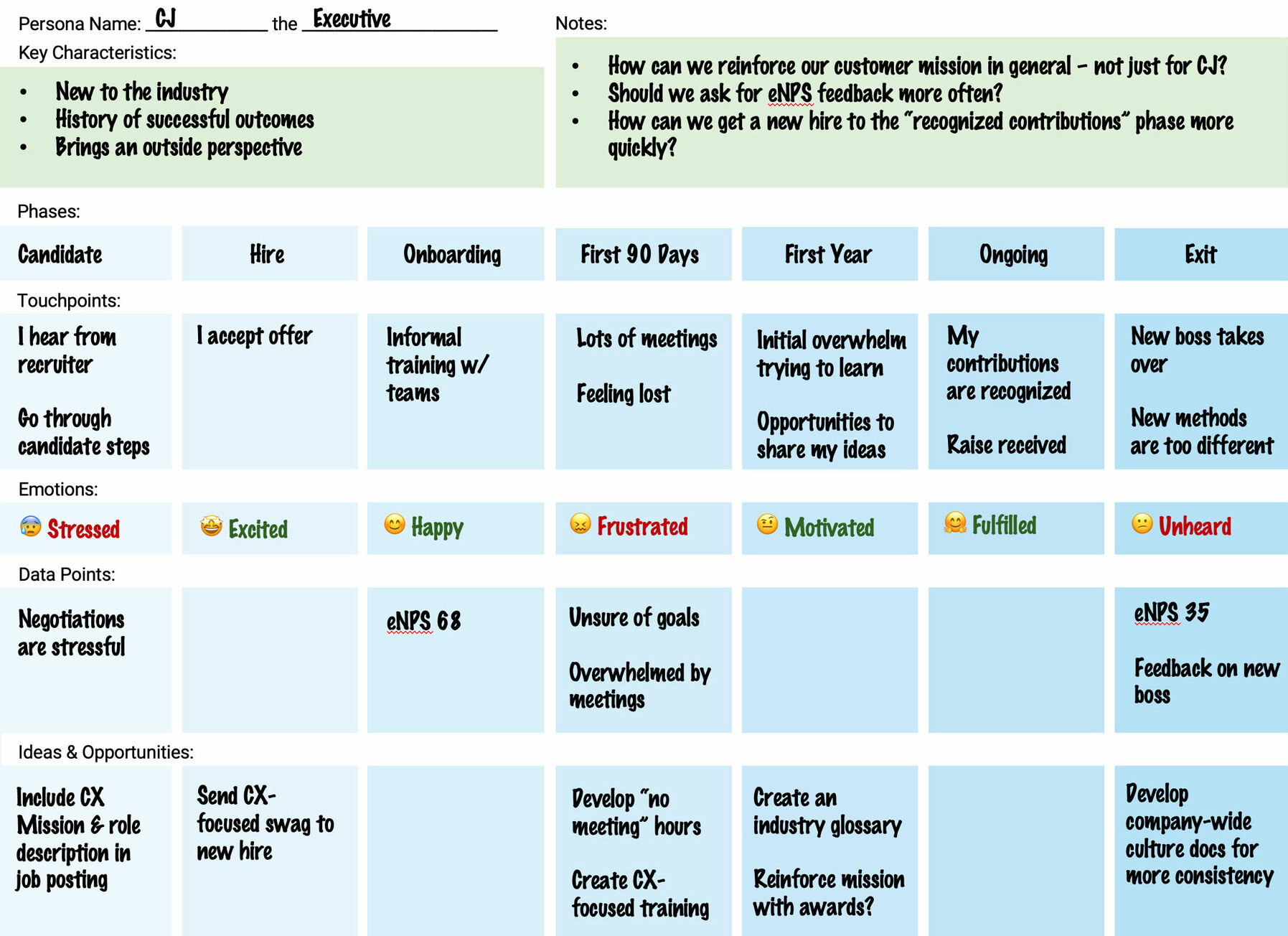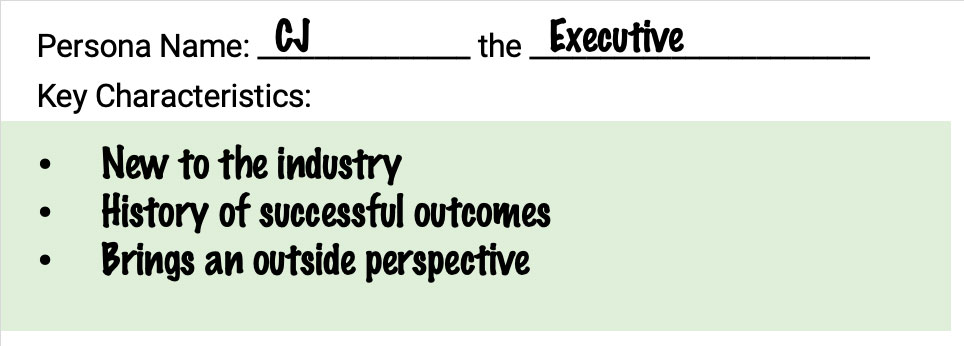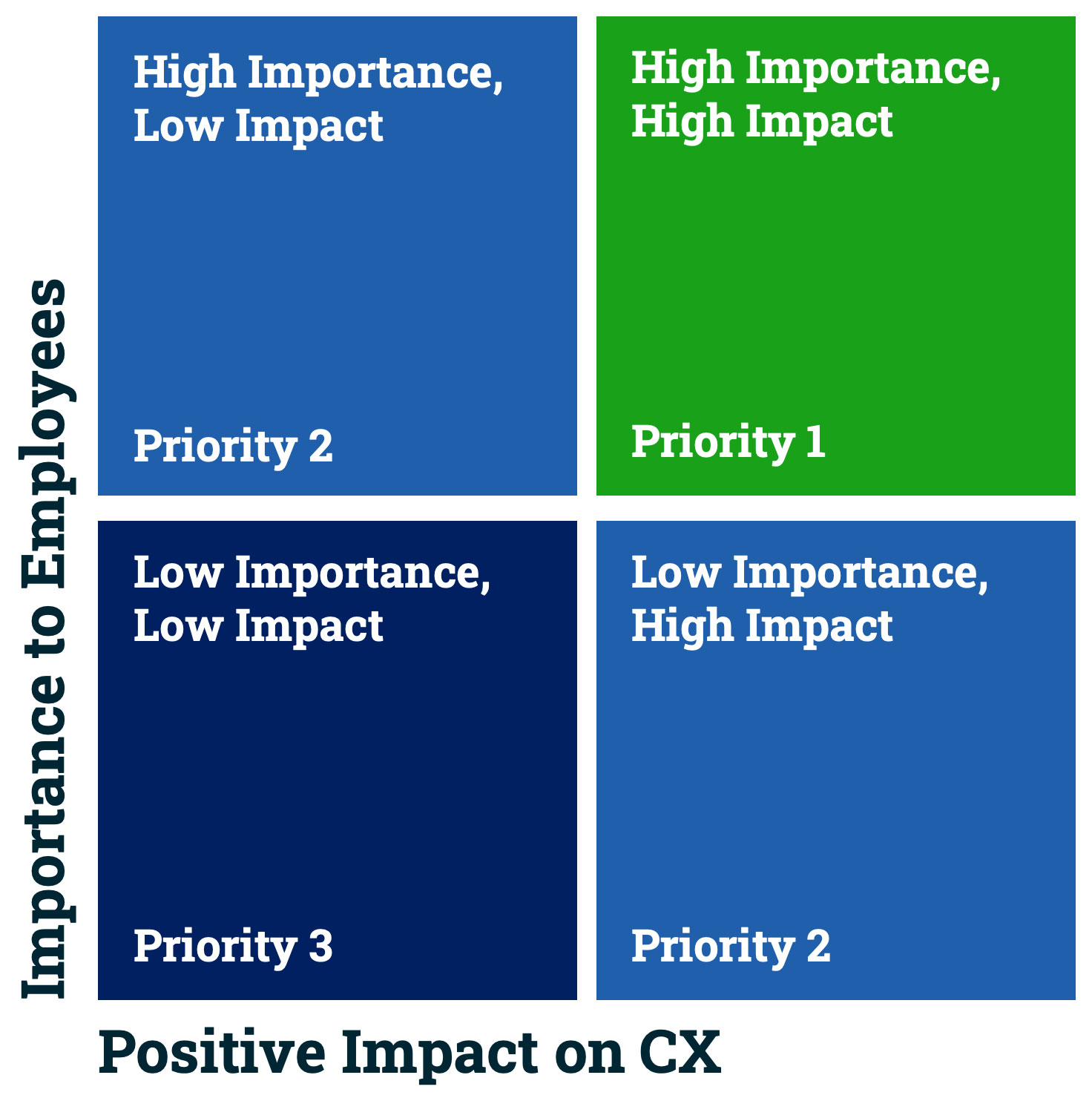If you’re familiar with customer journey mapping, then you may know more about employee journey mapping (EJM) than you realize.
Employee journey mapping uses the same concepts and best practices of customer journey mapping to help you:
What does an employee journey map look like? Here’s an example:

Chief Learning Officers, Chief Human Resources Officers, Talent Management executives and other employee-focused leaders are starting to rely on experience mapping to achieve better outcomes with both employees and the overall organization.
But just like with customer journey mapping, there are pitfalls and challenges to employee journey mapping. Based on what data, information and tools are available, getting the most out of your EJM initiatives can be difficult and complex.
If you’re considering employee journey mapping, here are some tips to get you started and help you take action quickly, avoiding many of the most common pitfalls.
Later this week we’ll be publishing a template as part of our Year of CX initiative. Learn more and sign up to receive this and other free tools, guides and templates here.
Just like customers, no two employees are alike. The new customer service agent has a very different employee journey than the Chief Innovation Officer.
Don’t make the mistake of trying to create a broad, one-size-fits-all employee journey map. Instead, consider tackling one employee journey at a time.
Like customer personas or avatars, employee personas can help you understand the specific challenges, opportunities and outcomes with one employee journey versus the next.
When building out these personas, avoid getting too caught up in demographics like gender, race, or age. Using initials to represent a persona can help with this. The focus should be on what an employee persona’s goals are, the obstacles they face, and the experience they have in their work.
It’s worth noting here there may be opportunities to use employee journey mapping to understand the journey of traditionally under-represented employees or other specific demographic groups, but for the sake of our example, we’re focusing on a persona in general terms.

In our example, we are mapping the experience of CJ the Executive at Company ABC. CJ is the persona for a high-level employee brought in from outside of the organization. CJ has succeeded with outcomes at other organizations and will bring an outside perspective to our business.
When it’s time to create additional employee personas, you can often leverage a specific persona you’ve already created, using what you’ve learned and adjusting as necessary.
This is the opposite of what I recommend for customer journey mapping. Since we’re talking about the internal organizational journey, it’s ok to label the various phases of the journey as your organization defines them. In our example for CJ, we use:

Your internal language might be different. In some cases, you may want to use more accomplishment-driven phases instead of time-based ones. This is especially important if you have a certification process or a probationary period as part of the journey.
Hopefully, there is at least some employee feedback and other data you can use to determine where the opportunities and challenges are. Gather what you can.
Data can come from both formal and informal inputs, like:

Just like in customer journey mapping, this is where the magic happens! Put things into a first-person perspective and include what CJ is doing, thinking, and feeling.

Consider what’s really happening from CJ’s perspective. It’s not “Recruiter reaches out.” It’s “I hear from a recruiter.” Flipping the script helps us see and consider touchpoints along the journey that are otherwise missed.
If you need help, do what you can to walk through the experience yourself. What is it like to apply for a role from outside of the company? What happens if you have a question or concern? Is it obvious how to get help? These are the types of scenarios you can evaluate with an employee journey map.
Employees have emotions, too. What are the highs and lows of the journey? What are the challenges and what feelings do those produce? Include what the data tells you. If there is a high percentage of employees who report a lower level of engagement after 90 days, what does that tell you? Are they feeling frustrated, confused or neglected? Tell that story in your journey map.
Invest in your employee’s positive emotions. If workers are stressed, frustrated, distrustful or cynical, then your customer experience most likely will be, too. What are the emotions you want your customers to experience? In an ideal employee journey map, those are represented.
Sit down with your leadership team and ask:
As you identify ideas and opportunities, add them to the map! In our example, these are listed below the specific phase on the journey.

Employee experience changes require commitment from a cross-functional leadership team. Investing in the right hiring, onboarding, training and ongoing communications around customer experience is where customer-centric brands differ from those who don’t prioritize customer experience.
This is also the time to include your employees. Invite some of them to share their opinions about the journey map and offer ideas, recommendations and feedback. Conduct some employee interviews to find out what’s most important to them, and how they would prioritize the changes.

What are the themes you’ve discovered about what’s most important to employees? Look for what themes align with the customer experience priorities. Use your Customer Experience Mission to help you determine what’s most important to employees, customers and your brand. What does the overall journey tell you about how you’re living up to the CX Mission WITHIN your organization?
For example, maybe part of your mission is to authentically show up for customers. If your employee journey map reveals that employees feel like they don’t have access to information or they will be punished for being honest, then that shows a serious misalignment of mission and real life. Those themes are there to show you where to invest to improve things for employees and customers.
A simple 4-square matrix can help. On the X axis, measure what employees shared was most important to them. On the Y axis, measure how these actions could impact your customer experience. The intersection of these priorities can help you see what’s going to have the biggest impact. This is hardly a perfect science, but listening and ongoing measuring can help you take steps in the right direction.
Let’s recap our 7 tips:
Then…don’t let up! Your employees need you to continue to focus on ways to engage them with the customer experience.
We’re here for you with tools to help:
When you’re ready, we can also help directly — with coaching, workshops, consulting, keynotes, and more.
 Jeannie is an award-winning customer experience expert, international keynote speaker, and sought-after business coach who is trailblazing the movement from “Reactive Customer Service” to “Proactive Customer and Employee Experience.” More than 500,000 people have learned from her CX courses on LinkedIn Learning, and her insights have been featured in Forbes, The Chicago Tribune, The Wall Street Journal and NPR.
Get Jeannie’s insights in your inbox each week by subscribing to The Weekly Win and follow her on LinkedIn, Instagram and YouTube.
Jeannie is an award-winning customer experience expert, international keynote speaker, and sought-after business coach who is trailblazing the movement from “Reactive Customer Service” to “Proactive Customer and Employee Experience.” More than 500,000 people have learned from her CX courses on LinkedIn Learning, and her insights have been featured in Forbes, The Chicago Tribune, The Wall Street Journal and NPR.
Get Jeannie’s insights in your inbox each week by subscribing to The Weekly Win and follow her on LinkedIn, Instagram and YouTube.